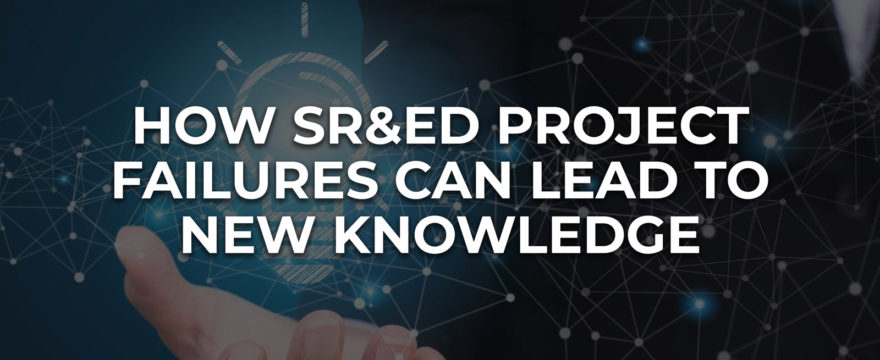
Research and development (R&D) work is costly, requiring a considerable investment of capital, labour, and time diverted from other projects. In addition to this expense, companies may be hesitant to undertake R&D efforts due to the risk of failure inherent in innovation. The Canada Revenue Agency created the Scientific Research & Experimental Development (SR&ED) program to overcome these concerns. By providing generous funding for eligible SR&ED projects, the government subsidizes a portion of the cost and risk involved in scientific and technological discovery with tax credits and refunds supplied for SR&ED-eligible expenses regardless of the work’s success or failure.
In fact, even a failed SR&ED project can offer new information, insight, and support for future developments. If your company’s SR&ED work fails to prove the expected hypothesis, it still makes an important contribution to your field and R&D efforts as a whole.
A Systematic Approach Yields New Knowledge
The Canadian Revenue Agency (CRA) mandates that all SR&ED-eligible expenses must be incurred during a systematic investigation or search. This approach helps prevent the use of taxpayer-generated monies for haphazard R&D work and requires that your project:
- Defines a technological or scientific uncertainty that cannot be resolved through existing means or established practices
- Advances a hypothesis to resolve the problem
- Tests the hypothesis through experimentation or analysis
- Develops a logical conclusion based on the results
By requiring this systematic approach, the CRA avoids funding trial-and-error-based efforts. While this phrase is commonly understood to mean “trying until you get it right,” the CRA defines trial and error as experimentation undertaken without order, organization, and/or a guiding hypothesis.
The agency’s objection to trial and error is in part what allows funds to support failed SR&ED projects. Should your team proceed without a systematic approach, nothing is learned from the resulting failure. Consider it this way: if you adjust an experiment by randomly changing chemical ratios each day for a month, there’s no way to tell why your assumption about the outcome was incorrect or why the daily changes failed to produce an expected result. When you conduct experimentation with a systematic approach, however, your team can understand why their efforts failed. This explanation itself can be valuable for your company’s future R&D work and can help other researchers avoid repetition of the errors made.
Your Due Diligence in Developing an SR&ED Project Is Valuable
SR&ED-eligible expenses must be dedicated to resolving a technological or scientific uncertainty. This means that when SR&ED projects are properly undertaken, due diligence is required to confirm a genuine question is at stake. It also requires companies to develop and clarify that question for research. Additionally, your company must dedicate substantial effort to identifying and disqualifying existing solutions and technologies to justify the eligibility of your expenditure.
This due diligence demonstrates that you’ve taken the required systematic approach, but also has value for scientific and technological discovery as a whole. By articulating a problem, your organization opens the door to future research on the matter, even if your own work fails to produce the desired results. When we consider the long history of scientific and technological innovation, it’s not difficult to find challenges that were undertaken by numerous parties with varying degrees of failure before arriving at a successful advancement. From the light bulb to the camera and even the ongoing development of COVID-19 vaccines, learning from failed attempts has proven invaluable.
A Critical Role in Canadian and Global Advancement
It’s important to keep in mind that the CRA does not include success or profitability in its statement of purpose for the SR&ED program. Instead, the agency states:
The Scientific Research and Experimental Development (SR&ED) Program uses tax incentives to encourage Canadian businesses of all sizes and in all sectors to conduct research and development (R&D) in Canada.
The reasons for this purpose are threefold. First, innovation benefits the country’s economy. New technologies drive business-to-business and consumer spending, create jobs and introduce greater efficiency across fields. Second, R&D work is essential for continued growth as an innovative country. Nationally, 0.84% of the GDP is dedicated to R&D, confirming that Canada has earned its reputation as a growing center of innovation. Yet this percentage ranks the country 8th among peers, suggesting the third reason for prioritizing support for SR&ED projects, including those that fail. The ranking indicates ample opportunity to devote greater funds to the projects that fuel innovation.
By encouraging domestic organizations to undertake R&D work, the federal government minimizes the need to rely on off-shore innovators and keeps a greater portion of their investment engaged domestically. This means that even failed SR&ED projects contribute to the nation’s growing prominence among innovators on a global scale and helps grow an ever-expanding base of domestic scientific and technological knowledge.
Support Your R&D Work with Fast SR&ED Financing
Successful demonstration of a hypothesis is the goal for every SR&ED project. However, due to the advancement of knowledge and progress toward future innovations, even failed projects offer a degree of success to your company, the federal government, and technological growth around the world. With this understanding of the SR&ED program in mind, receiving your refund in a timely fashion to continue R&D work is more important than ever.
Processing SR&ED claims submitted at the end of the tax year is time-consuming, and audits can delay your refund even further. To avoid this hassle and access the capital needed for innovation, turn to our Capital-as-a-Service (CaaS) platform. We make it easy to access your refund in quarterly advances and can provide your first payment in as little as 72 hours after a successful application.
Don’t wait for your refund any longer – contact us today.
.png)
.png)
.png)
